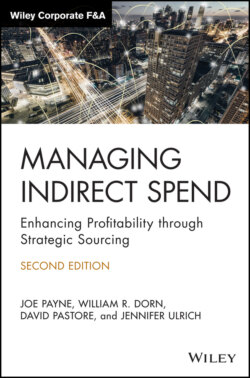Читать книгу Managing Indirect Spend - Joseph Payne, Joe Payne - Страница 15
CHAPTER 1 An Introduction to Strategic Sourcing
ОглавлениеMANY AUTHORS HAVE ALREADY WRITTEN on Strategic Sourcing and Supply Chain Management. In general, each describes a sourcing process that includes somewhere between five and seven steps. The primary differences among their books are in the ways those steps are defined and segmented. The process described in this book should look familiar in that it includes six steps, starting with the inception of the initiative (Project Kickoff) and concluding with final monitoring of the implemented program (Continuous Improvement). This book's process, however, specifically applies Strategic Sourcing techniques to indirect spend categories and offers insights and strategies that have been applied successfully for decades. Our process is not based on theory; the techniques described have been refined through years of experience alongside many types of organizations to reduce their costs for indirect goods and services. As you will discover, the process itself serves primarily as a project management tool. Creative strategies and adaptability in the face of uncertainty are the key elements that make your sourcing initiative truly strategic.
In the first edition of this book, published back in 2010, we noted that many organizations still neglected to apply Strategic Sourcing techniques to their indirect spend categories. Instead, indirect spend was treated as a series of one‐off purchases or was sourced with a simple three‐bid strategy with little effort beyond reviewing the supplier price responses. Typically, with indirect spend, per‐item prices are relatively low, the product or service is not crucial to the business, and the overall costs are rarely examined because of the difficulty entailed in gathering meaningful spend and market data.
Things have changed in the years since our first edition, but not as much as we might have hoped. Most organizations are now familiar with a Strategic Sourcing process. True best practices for sourcing indirect spend, however, are still rare. Sourcing managers are still accustomed to the old way of running bids and still continue to engage suppliers at arm's‐length, which does not engage the supplier community in a way that maximizes competition. Concepts like category management have become even more important, yet even organizations with dedicated category managers suffer from diminishing returns and increased costs as they attempt to hire in‐house specialists for virtually every category of spend.
In the current world of procurement, leaders and managers shouldn't focus on effective sourcing processes alone, but they should also turn their attention toward ensuring a high return on investment for the function, creating efficiency and effectiveness metrics that drive results faster, increasing visibility, and engaging their stakeholders and suppliers effectively. Strategic Sourcing, combined with proper category management techniques, continues to allow organizations to shift away from thinking about indirect spend in an ad hoc manner and provides spend visibility, objective decision‐making, and a project management tool to ensure efficient use of the sourcing team's time and efforts.
